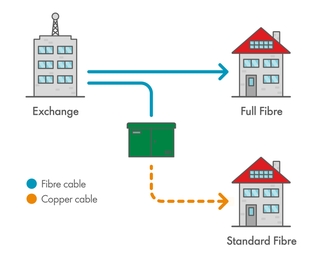What is Full Fibre broadband: FTTP explained
16 November 2021

If you remember the days of dial-up internet and those screeching sounds that took you on a journey to the world wide web, you’ll undoubtedly be grateful for today’s browsing speeds. Over the years, we’ve become accustomed to instant internet access and reliable connections thanks to numerous upgrades to our broadband infrastructure.
And now, with fibre-to-the-premises (FTTP), connections are even more secure and speeds are faster than ever before. The introduction of this new technology is a game-changer that has seen homes and businesses all over the UK enjoy even faster and more secure connections to the internet.
Here’s everything you need to know about FTTP, from how it works, to where it’s available.
What is FTTP?
FTTP, otherwise known as fibre-to-the-premises, is lightning fast broadband. FTTP provides a pure fibre connection that goes from the exchange straight into your home. The result is internet speeds of up to 1Gpbs.
Broadband services powered by FTTP also provide the most reliable and secure connection. These attributes combined make it the best broadband available on the market, and an increasingly popular choice if you’re looking to supercharge your internet connection.
How does FTTP work?
FTTP is a technology that provides seamless access to the internet by running fibre-optic cables directly from the exchange into your home or business. It’s essentially an end-to-end fibre cable service from the exchange to your home. A fibre cable is stronger and doesn't disintegrate over time, unlike copper. It bypasses the need for a copper wire, which means it can go straight into your home.

How is it different from FTTC?
FTTC, or fibre-to-the-cabinet, is currently the most common form of broadband, and provides a part-copper, part-fibre connection. The fibre cabling connects from the exchange to the green cabinet on your street, while a copper cable links the cabinet to your home and acts as an intermediary between the two.
The existing copper lines were originally created for telephony services and have been adapted to allow a broadband service across them. Fibre-optic is specifically designed to carry broadband service. FTTC can still deliver a speedy internet connection, but it’s not as fast or as reliable as FTTP.
Where is FTTP available?
FTTP is reaching more homes and businesses every day - by the end of December 2026, FTTP should reach over 25 million premises. Is your area FTTP ready? Check your availability today and find out if your home is ready for the next level of broadband.
Just how fast is FTTP?
If you’re feeling the need for speed, FTTP should be your first choice. Currently, the UK’s average broadband speed sits at just 80Mbps. Our Full Fibre broadband utilises FTTP technology and our fastest package can reach average speeds of 900Mbps and maximum speeds of 1Gbps.
Our other Full Fibre packages feature average speeds of 100, 200, 300 and 500Mbps, giving customers the choice to decide which package best suits their home. FTTP is typically faster than other broadband types, and it provides increased reliability and a more stable connection for users.
Ready for the next level of broadband?
Check out our Full Fibre page to see our latest lineup of Full Fibre packages, offering lightning-fast FTTP broadband with speeds over 10 times faster than the UK’s average.* The future of broadband is here.